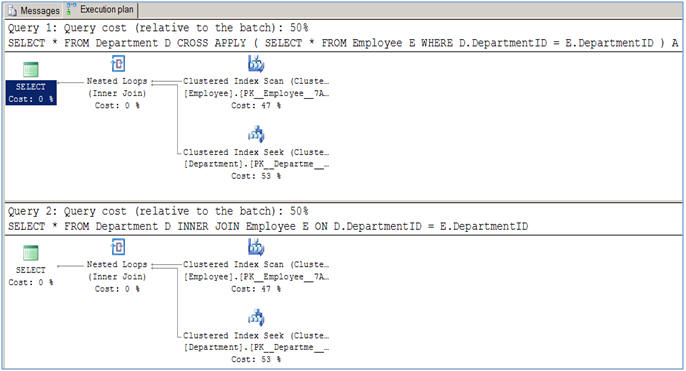Consider you have two tables.
MASTER TABLE
x------x--------------------x
| Id | Name |
x------x--------------------x
| 1 | A |
| 2 | B |
| 3 | C |
x------x--------------------x
DETAILS TABLE
x------x--------------------x-------x
| Id | PERIOD | QTY |
x------x--------------------x-------x
| 1 | 2014-01-13 | 10 |
| 1 | 2014-01-11 | 15 |
| 1 | 2014-01-12 | 20 |
| 2 | 2014-01-06 | 30 |
| 2 | 2014-01-08 | 40 |
x------x--------------------x-------x
There are many situations where we need to replace INNER JOIN with CROSS APPLY.
1. Join two tables based on TOP n results
Consider if we need to select Id and Name from Master and last two dates for each Id from Details table.
SELECT M.ID,M.NAME,D.PERIOD,D.QTY
FROM MASTER M
INNER JOIN
(
SELECT TOP 2 ID, PERIOD,QTY
FROM DETAILS D
ORDER BY CAST(PERIOD AS DATE)DESC
)D
ON M.ID=D.ID
The above query generates the following result.
x------x---------x--------------x-------x
| Id | Name | PERIOD | QTY |
x------x---------x--------------x-------x
| 1 | A | 2014-01-13 | 10 |
| 1 | A | 2014-01-12 | 20 |
x------x---------x--------------x-------x
See, it generated results for last two dates with last two date's Id and then joined these records only in the outer query on Id, which is wrong. This should be returning both Ids 1 and 2 but it returned only 1 because 1 has the last two dates. To accomplish this, we need to use CROSS APPLY.
SELECT M.ID,M.NAME,D.PERIOD,D.QTY
FROM MASTER M
CROSS APPLY
(
SELECT TOP 2 ID, PERIOD,QTY
FROM DETAILS D
WHERE M.ID=D.ID
ORDER BY CAST(PERIOD AS DATE)DESC
)D
and forms the following result.
x------x---------x--------------x-------x
| Id | Name | PERIOD | QTY |
x------x---------x--------------x-------x
| 1 | A | 2014-01-13 | 10 |
| 1 | A | 2014-01-12 | 20 |
| 2 | B | 2014-01-08 | 40 |
| 2 | B | 2014-01-06 | 30 |
x------x---------x--------------x-------x
Here's how it works. The query inside CROSS APPLY can reference the outer table, where INNER JOIN cannot do this (it throws compile error). When finding the last two dates, joining is done inside CROSS APPLY i.e., WHERE M.ID=D.ID.
2. When we need INNER JOIN functionality using functions.
CROSS APPLY can be used as a replacement with INNER JOIN when we need to get result from Master table and a function.
SELECT M.ID,M.NAME,C.PERIOD,C.QTY
FROM MASTER M
CROSS APPLY dbo.FnGetQty(M.ID) C
And here is the function
CREATE FUNCTION FnGetQty
(
@Id INT
)
RETURNS TABLE
AS
RETURN
(
SELECT ID,PERIOD,QTY
FROM DETAILS
WHERE ID=@Id
)
which generated the following result
x------x---------x--------------x-------x
| Id | Name | PERIOD | QTY |
x------x---------x--------------x-------x
| 1 | A | 2014-01-13 | 10 |
| 1 | A | 2014-01-11 | 15 |
| 1 | A | 2014-01-12 | 20 |
| 2 | B | 2014-01-06 | 30 |
| 2 | B | 2014-01-08 | 40 |
x------x---------x--------------x-------x
ADDITIONAL ADVANTAGE OF CROSS APPLY
APPLY can be used as a replacement for UNPIVOT. Either CROSS APPLY or OUTER APPLY can be used here, which are interchangeable.
Consider you have the below table(named MYTABLE).
x------x-------------x--------------x
| Id | FROMDATE | TODATE |
x------x-------------x--------------x
| 1 | 2014-01-11 | 2014-01-13 |
| 1 | 2014-02-23 | 2014-02-27 |
| 2 | 2014-05-06 | 2014-05-30 |
| 3 | NULL | NULL |
x------x-------------x--------------x
The query is below.
SELECT DISTINCT ID,DATES
FROM MYTABLE
CROSS APPLY(VALUES (FROMDATE),(TODATE))
COLUMNNAMES(DATES)
which brings you the result
x------x-------------x
| Id | DATES |
x------x-------------x
| 1 | 2014-01-11 |
| 1 | 2014-01-13 |
| 1 | 2014-02-23 |
| 1 | 2014-02-27 |
| 2 | 2014-05-06 |
| 2 | 2014-05-30 |
| 3 | NULL |
x------x-------------x


CROSS APPLYhas its obvious usage in allowing a set to depend on another (unlike theJOINoperator), but that doesn't comes without a cost: it behaves like a function that operates over each member of the left set, so, in SQL Server terms it always perform aLoop Join, which almost never is the best way to join sets. So, useAPPLYwhen you need to, but don't overuse it againstJOIN. – Shanks